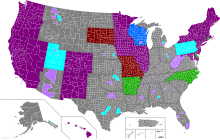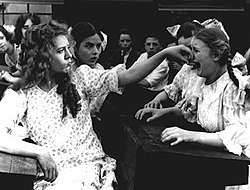School bullying
The examples and perspective in this article may not represent a worldwide view of the subject. |

School bullying is a type of bullying that occurs in connection with education, either inside or outside of school. Bullying can be physical, verbal, or emotional and is usually repeated over a period of time.[1][2]
School shootings have focused attention on student bullying, with shooters in several of the worst shootings reporting they were bullied.
Studies prompted by the shootings have shown long-lasting emotional harm to victims. The studies also revealed that bullies themselves are likely to suffer problems as children and adults.[3]
Many educational institutions have implemented anti-bullying campaigns. Studies in Norway and England confirm these programs can be effective. The programs usually focus on increasing awareness and supervision, establishing clear rules, and providing support and protection for victims.
Children who are gay or gender variant are particularly vulnerable to bullying. The gender variant child may well wish to transition to his/her affirmed gender role and this needs particularly sensitive treatment by the school. A recent publication, sponsored by the United Kingdom Home Office gives a number of case studies of transsexual children and provides a toolkit for schools to deal with the issues that arise [4].
Types of bullying and what it means to bully
School bullying is behavior intended to harm or disturb the victim. It can be physical or emotional and can occur in person, electronically, or indirectly.
Physical school bullying

Examples of physical bullying include:[1]
- Punching
- Shoving
- Slapping
- Other acts that hurt people physically and emotionally
- Wedgies [of all types]
- Attacking
- Pranks
- Teasing and abusing
Emotional school bullying
Examples of emotional bullying include:[1]
- Spreading bad rumors about people
- Keeping certain people out of a "group"
- Teasing people in mean ways
- Getting certain people to "gang up" on others
- Name calling
- Taunts, Insults etc
- Harassment
- Provocation
- Tormenting
Electronic bullying: (cyber-bullying)
Bullying also can happen on-line or electronically. This form of harassment is known as Cyber-bullying. It occurs when someone bullies through the Internet, mobile phones or other electronic means.[1] Examples include:
- Sending mean-spirited text, e-mail, or instant messages.
- Posting inappropriate pictures or messages about others in blogs or on Web sites.
- Using someone else's user name to spread rumors or lies about someone.
- Lying to hurt internally and externally.
Who bullies
This article contains weasel words: vague phrasing that often accompanies biased or unverifiable information. (September 2009) |
One student or a group can bully another student or a group of students. Bystanders may participate or watch, sometimes out of fear of becoming the next victim. However, there is some research suggesting that a significant proportion of "normal" school children may not evaluate school-based violence (student-on-student victimization) as negatively or as being unacceptable as much as adults generally do, and may even derive enjoyment from it, and they may thus not see a reason to prevent it if it brings them joy on some level.[5]
Bullying can also be perpetrated by teachers and the school system itself: there is an inherent power differential in the system that can easily predispose to subtle or covert abuse, humiliation, or exclusion - even while maintaining overt commitments to anti-bullying policies.[6][7][8]
Strategies to reduce bullying within schools
Researchers (Olweus, 1993;[9] Craig & Peplar, 1999;[10] Ross, 1998;[11] Morrison, 2002;[12] Whitted & Dupper, 2005;[13]
You can help your child deal with the situation by helping them to not be an easy target for a bully. Teach them to stand up straight, speak with a clear voice, and to look their peers in the eyes. By carrying themselves in this way, they will not appear weak or vulnerable. Explain to them that bullies generally try to find children that are alone where that they can’t be seen or heard.
In popular culture
Bullies frequently appear as antagonists in TV shows about young people. For example, on the TV series Malcolm in the Middle, Malcolm's older brother Reese is notoriously known as the school and neighborhood bully. The Fresh Prince of Bel-Air also featured a bully who picked on Ashley Banks and who comes from a bullying family.
In the musical 'Missing Mel' (in association with Youth Music Theatre: UK), there is an entire number that revolves around two twins bullying a girl named Lauren. This musical has been praised for raising the awareness of the harm bullying can do to a victim.[citation needed]
See also
References
- ^ a b c d Stop Bullying Now! Information, Prevention, Tips, and Games.
- ^ Teen Bully
- ^ Bullying Widespread in U.S. Schools
- ^ Bernard, Reed (2008). "Combating Transphobic Bullying: Toolkit for Schools" (pdf). Gender Identity Research and Education Society. Retrieved 2008-10-03.
{{cite web}}: Unknown parameter|coauthors=ignored (|author=suggested) (help); Unknown parameter|month=ignored (help) - ^ Kerbs, J.J. & Jolley, J.M. The Joy of Violence: What about Violence is Fun in Middle-School? American Journal of Criminal Justice. Vol. 32, No. 1-2/ Oct. 2007.
- ^ Garbarino, J. & de Lara, E. (2003). And Words CAN Hurt Forever: How to Protect Adolescents from Bullying, Harassment, and Emotional Violence. The Free Press: New York NY.
- ^ Whitted, K.S. (2005). Student reports of physical and psychological maltreatment in schools: An under-explored aspect of student victimization in schools. University of Tennessee.
- ^ Whitted, K. S. & Dupper, D. R. Do Teachers Bully Students?: Findings from a Survey of Students in an Alternative Education Setting. Education and Urban Society, 2008, 40(3), 329-341.
- ^ Olweus, D. (1993). Bullying at school: What we know and what we can do. Oxford Blackwell Publishers.
- ^ Craig, W.M. & Peplar, D.J. (1999). Children who bully - Will they just grow out of it? Orbit, 29 (4), 16 - 19.
- ^ Ross, P.N. (1998). Arresting violence: a resource guide for schools and their communities. Toronto: Ontario Public School Teachers' Federation.
- ^ Morrison, B. (2002). Bullying and victimisation in schools: a restorative justice approach. Trends and Issues in Crime and Criminal Justice. No.219; Feb. 2002. Australian Institute of Criminology.
- ^ Whitted, K.S. & Dupper, D.R. (2005). Best Practices for Preventing or Reducing Bullying in Schools. Children and Schools, Vol. 27, No. 3, July 2005 , pp. 167-175(9).
External links
- Make Your Child Bully Proof
- ”Bullying Widespread in U.S. Schools, Study Finds”, National Institutes of Health
- Stop Bullying Now, Health Resources and Services Administration
- MommaWorks: Great Ideas for Busy Moms
- Bullying Affects All Middle School Kids, Substance Abuse and Mental Health Services Administration (SAMHSA)
- Girls Bullying Girls: An Introduction to Relational Aggression, National Association of School Psychologists
- PROJECT ROCKIT: Anti-bullying program run BY young people FOR young people
- Middle School Anti-Bullying Program
